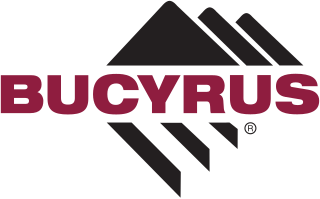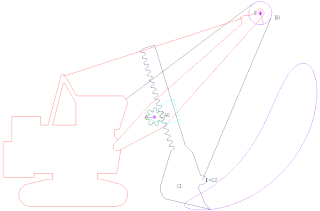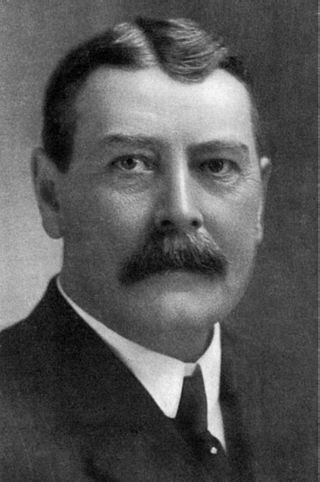
Excavators are heavy construction equipment primarily consisting of a boom, dipper, bucket and cab on a rotating platform known as the "house" - although the largest form ever, the dragline excavator, eliminated the dipper in favor of a line and winch.

Heavy equipment, heavy machinery, earthmovers, construction vehicles, or construction equipment, refers to heavy-duty vehicles specially designed to execute construction tasks, most frequently involving earthwork operations or other large construction tasks. Heavy equipment usually comprises five equipment systems: the implement, traction, structure, power train, and control/information.

A dragline excavator is a heavy-duty excavator used in civil engineering and surface mining. It was invented in 1904, and presented an immediate challenge to the steam shovel and its diesel and electric powered descendant, the power shovel. Much more efficient than even the largest of the latter, it enjoyed a heyday in extreme size for most of the 20th century, first becoming challenged by more efficient rotary excavators in the 1950s, then superseded by them on the upper end from the 1970s on.

Rutland Railway Museum, now trading as Rocks by Rail: The Living Ironstone Museum, is a heritage railway on part of a former Midland Railway mineral branch line. It is situated north east of Oakham, in Rutland, England.

A steam shovel is a large steam-powered excavating machine designed for lifting and moving material such as rock and soil. It is the earliest type of power shovel or excavator. Steam shovels played a major role in public works in the 19th and early 20th century, being key to the construction of railroads and the Panama Canal. The development of simpler, cheaper diesel, gasoline and electric shovels caused steam shovels to fall out of favor in the 1930s.

Ruston & Hornsby was an industrial equipment manufacturer in Lincoln, England founded in 1918. The company is best known as a manufacturer of narrow and standard gauge diesel locomotives and also of steam shovels. Other products included cars, steam locomotives and a range of internal combustion engines, and later gas turbines. It is now a subsidiary of Siemens.

Marion Power Shovel Company was an American firm that designed, manufactured and sold steam shovels, power shovels, blast hole drills, excavators, and dragline excavators for use in the construction and mining industries. The company was a major supplier of steam shovels for the construction of the Panama Canal. The company also built the two crawler-transporters used by NASA for transporting the Saturn V rocket and later the Space Shuttle to their launch pads. The company's shovels played a major role in excavation for Hoover Dam, the Holland Tunnel and the extension of the Number 7 subway line to Main Street in Flushing, Queens.

Bucyrus-Erie was an American surface and underground mining equipment company. It was founded as Bucyrus Foundry and Manufacturing Company in Bucyrus, Ohio, in 1880. Bucyrus moved its headquarters to South Milwaukee, Wisconsin, in 1893. In 1927, Bucyrus merged with the Erie Steam Shovel Company to form Bucyrus-Erie. In 1997, it was renamed Bucyrus International, Inc. In 2010 the enterprise was purchased by Caterpillar in a US$7.6 billion transaction that closed on July 8, 2011. At the time of its acquisition, the Bucyrus product line included a range of material removal and material handling products used in both surface and underground mining.

A power shovel, also known as a motor shovel, stripping shovel, front shovel, mining shovel or rope shovel, is a bucket-equipped machine usually powered by steam, diesel fuel, gasoline or electricity and used for digging and loading earth or fragmented rock and for mineral extraction. Power shovels are a type of rope/cable excavator, where the digging arm is controlled and powered by winches and steel ropes, rather than hydraulics like in the modern hydraulic excavators. Basic parts of a power shovel include the track system, cabin, cables, rack, stick, boom foot-pin, saddle block, boom, boom point sheaves and bucket. The size of bucket varies from 0.73 to 53 cubic meters.

Newton, Chambers & Co. was one of England's largest industrial companies. It was founded in 1789 by George Newton and Thomas Chambers.
The Osgood Company was a Marion, Ohio based manufacturer of heavy machinery, producing steam shovels, dragline excavators and cranes. What would eventually become Osgood Company was founded in 1910 as Marion Steam Shovel and Dredge Company by A.E. Cheney, the former head of sales for the Marion Steam Shovel Company. Marion Power Shovel acquired Osgood Company in 1954 and integrated Osgood's products into the Marion Power Shovel product line.

Ransomes & Rapier was a major British manufacturer of railway equipment and later cranes, from 1869 to 1987. Originally an offshoot of the major engineering company Ransome's it was based at Waterside Works in Ipswich, Suffolk.

Ruston-Bucyrus Ltd was an engineering company established in 1930 and jointly owned by Ruston & Hornsby based in Lincoln, England, and Bucyrus-Erie based in South Milwaukee, Wisconsin, the latter of which had operational control and into which the excavator manufacturing operation of Ruston & Hornsby was transferred. The Bucyrus company proper, from which the Bucyrus component of the Ruston-Bucyrus name was created, was an American company founded in 1880, in Bucyrus, Ohio.
Marion 6360, also known as The Captain, was a giant power shovel built by the Marion Power Shovel company. Completed and commissioned on October 15 1965, it was one of the largest land vehicles ever built, exceeded only by some dragline and bucket-wheel excavators. The shovel originally started work with Southwestern Illinois Coal Corporation, but the owners were soon bought out by Arch Coal. Everything remained the same at the mine except for the colors which were changed to red, white, and blue. Like most mining vehicles of extreme size, Marion 6360 only required a surprisingly small amount of men to operate, a total of four consisting of a operator, oiler, welder, and a ground man who looked after the trailing cable.

P&H Mining Equipment sells drilling and material handling machinery under the "P&H" trademark. The firm is an operating subsidiary of Joy Global Inc. In 2017 Joy Global Inc. was acquired by Komatsu Limited of Tokyo, Japan, and is now known as Komatsu Mining Corporation and operates as a subsidiary of Komatsu.

Joy Global Inc. was a company that manufactured and serviced heavy equipment used in the extraction and haulage of coal and minerals in both underground and surface mining. The company had manufacturing facilities in Alabama, Pennsylvania, Texas, Wisconsin, Australia, Canada, China, France, South Africa, Poland and the United Kingdom. In 2017, Joy Global was acquired by Komatsu Limited and was renamed Komatsu Mining Corp.
LiuGong, officially Guangxi LiuGong Machinery Co., Ltd., is a Chinese multinational construction machinery manufacturing company headquartered in Liuzhou, China. It is the world's 10th-largest construction equipment manufacturer by market share and the world's largest manufacturer of wheel loaders.
Hitachi Construction Machinery Co., Ltd. (日立建機株式会社) is a Japanese construction equipment company which is into the manufacturing, sales and service of construction machinery, transportation machinery, and other machines and devices. It is no longer a subsidiary of the Hitachi Group.

Link-Belt Cranes is an American industrial company that develops and manufactures heavy construction equipment, specializing in telescopic and lattice boom cranes. Link-Belt is headquartered in Lexington, Kentucky, and is a subsidiary of the Japanese conglomerate, Sumitomo Heavy Industries.
LBX is an American industrial company manufacturing excavators, forestry equipment and scrap material handlers.















